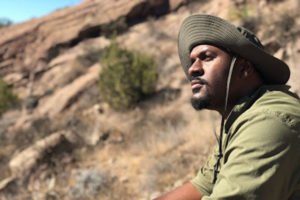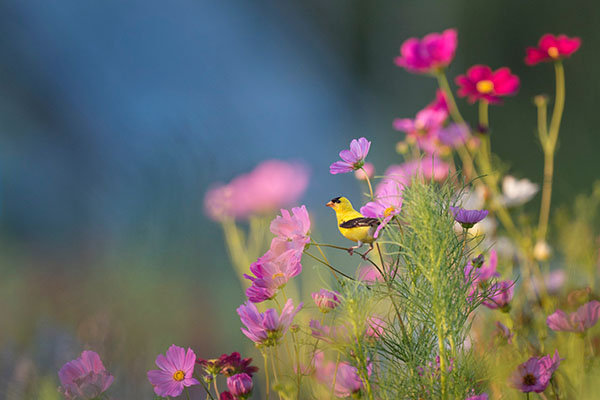Bring biomimicry education into your community, further your own learning through professional development, and hear from practitioners in the new biographies series.
As April blooms each year to the Northern Hemisphere, new action blossoms in the climate movement. The world turns their attention to Earth, celebrating and honoring the planet that provides us with the resources we need to survive. The theme this year is Invest in Our Planet; and to us, it signals a shift to reciprocity.
The time is now to change the way we perceive our interconnected relationship with each other and the ecosystems we call home. How we take action on a changing climate, social justice, and the way business functions requires courage and thoughtful intention. To preserve and protect our livelihoods requires us to invest in solutions inspired by nature.
Asking nature for guidance for solving problems is not new. For millennia, humans have modeled the creative wisdom of natural solutions in all kinds of design—from cultivating food sources to storing water to building homes. It is only in the last few hundred years that some humans lost their way and designed for competition over collaboration, for scarcity over abundance, and for destruction over preservation. In this wake, we have faced instability in our once-balanced ecosystems. The rapid acceleration of climate change not only threatens the safety of our own species but all species that cohabitate this planet.
The good news is that we have solutions available to us now. When we choose to employ our creativity and ingenuity in a way that restores our connection to the natural world, we will find that our decisions can positively impact the functioning of these ecosystems we so intimately rely on.
Where does one start? As individuals we can look at our own impact. What lands do we touch? How do our choices affect our health, families, local communities, businesses, industries, and society as a whole? Each action begins at home inside each individual, and it is through our collective collaboration that we may form a strong partnership with the natural world to make real change happen.
This Earth Day, we want to empower more people far-and-wide to connect with nature and their local communities, and to begin their own personal journeys in adopting biomimicry principles across their areas of impact. Regardless of one’s age, location, or experience, many of us want to play an active role in creating positive change. Whether seeking to solve grand issues related to climate change or local challenges related to safe drinking water, education, or fair housing, biomimicry offers a platform for introducing new solutions that are resilient and interconnected.
 By applying nature’s design lessons, we can create solutions that help support a healthy planet. Teaching biomimicry doesn’t need to be complicated. It’s simply about offering a lens to see the world: we are humans, a member of the animal kingdom here on planet Earth. In order to survive, we must relearn our place in the natural world.
By applying nature’s design lessons, we can create solutions that help support a healthy planet. Teaching biomimicry doesn’t need to be complicated. It’s simply about offering a lens to see the world: we are humans, a member of the animal kingdom here on planet Earth. In order to survive, we must relearn our place in the natural world.
We’ve designed a new guide to help you introduce the primary lessons to any age or discipline that is not yet familiar with the concept of biomimicry. Introducing: The Community Guide to Putting Nature Back into Human Nature. The best way to make global change happen is to start with a local approach. This guide serves as a way to bring biomimicry into your community so you can feel empowered to spread hope and action.
Taking Biomimicry Practice to the Next Level
While the new community guide serves as an introduction to the basics of biomimicry, if you’d like to accelerate your own learning journey, here are some resources to help.
Biomimicry Toolbox: The toolbox provides a deeper orientation to biomimicry and introduces a set of tools and core concepts that can help problem-solvers from any discipline begin to incorporate insights from nature into their solutions. If you have an audience that is ready to take on a local problem, you can use this free resource to work through the challenge and create a nature-inspired solution.
AskNature.org: The living world holds answers for us to create a more resilient, regenerative, and beautiful world. “How does nature solve this?” is the question we pose. Discover thousands of resources—including biological strategies, innovations inspired by nature, articles, videos, lesson plans, activities for groups, and more—available to folks who want to learn, teach, and practice.
Learn Biomimicry Online Course: Learn Biomimicry is an online course offering created by BiomimicrySA (South Africa) in partnership with the Biomimicry Institute. Gain a comprehensive understanding of the concepts, tools, and terminology of biomimicry, and learn the steps of how to put biomimicry into practice.
Become a Biomimicry Professional: Biomimicry 3.8 and Arizona State University are training the next generation of biomimicry practitioners from all backgrounds – with remote, accredited Master of Science and Graduate Certification programs. The Biomimicry Professional Certification Program combines the MSc with additional, in-person training led by Biomimicry 3.8. Designed to empower change-agents passionate about a world mentored by life’s genius, the program develops a compelling vision for you as a biomimicry thought leader in the world’s sustainable transformation.
Learn about other pathways to online learning and coursework for biomimicry.
Hear from Professionals in the New Biomimicry Biographies
 In January, our Youth Education team kicked off a 6-part series featuring professionals that offer future practitioners of biomimicry sound advice. The goal of this series aims to help young learners and adults alike to share their work as biomimics, and how this framework has changed their careers and personal lives. Watch their short videos and read their interviews here: Biomimicry Biographies.
In January, our Youth Education team kicked off a 6-part series featuring professionals that offer future practitioners of biomimicry sound advice. The goal of this series aims to help young learners and adults alike to share their work as biomimics, and how this framework has changed their careers and personal lives. Watch their short videos and read their interviews here: Biomimicry Biographies.
Whether you plan to organize an event for your local school this coming Earth Day or further your own education, we hope you feel empowered with the tools and knowledge you need to play a role in shifting our collective culture. May we together take a step back to see our influence, redefine our values, and take the necessary steps forward in reconnecting with nature and designing our lives in ways that creates a thriving, diverse, and resilient ecosystem.
And if you take anything away from this article, let it be this: go outside! When we become more deeply aware of the natural world around us, our appreciation and empathy grows, and we can begin to truly heal. By putting nature back into human nature, we are shifting our behavior to act with the remembrance that we are already home—here, living inseparably connected to the natural world.

